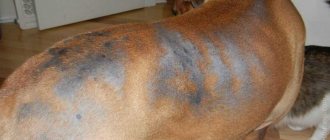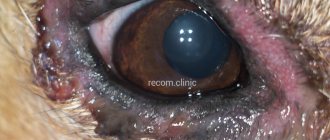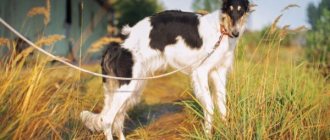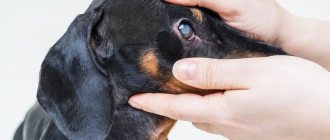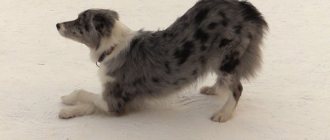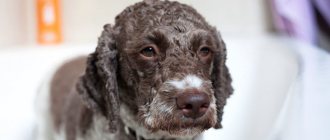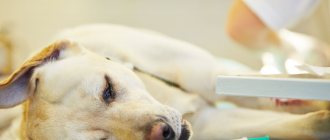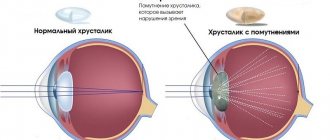What does it look like
It's quite easy to identify him. After all, every person has seen a sneezing dog. Here the picture is exactly the same, but the sneezing itself does not look like a sharp exhalation, but like an inhalation. Moreover, most often a whole series of similar sneezes occurs. Usually such convulsive breaths are accompanied by grunting or snorting. In some cases, dogs stretch their necks, lie on their stomachs, fall on their front paws, or tense their pectoral muscles. Some breeds may experience an increased amount of saliva produced.
The duration of attacks is rarely long - they are almost always limited to one minute or even less. Once completed, the dog behaves normally, showing no symptoms of pain or discomfort.
But outwardly it looks quite scary - an inexperienced owner may immediately think that the dog is having some kind of dangerous attack or is suffocating. However, there is usually no reason for concern and an immediate visit to the veterinarian; as long as you dial the phone or look for the car keys, the symptoms of reverse sneezing in your dog will pass.
What breeds does it occur in?
In general, reverse sneezing can be seen in dogs of almost all breeds. But first of all, small dogs are susceptible to this: French bulldogs, pugs, Pekingese, poodles, Yorkies, toy terriers. This is due to the structural features of the skull - note that all the breeds listed above have a short muzzle. Most often it is the elongated soft palate. When you inhale sharply before a normal sneeze, it can be sucked into your windpipe, causing reverse sneezing.
Of course, it sounds quite creepy, and it doesn’t look too fun. But it’s worth repeating, in most cases there is no reason to worry too much and visit a veterinarian.
Causes of reverse sneezing
Unfortunately, doctors have not yet established the exact causes of reverse sneezing in dogs. There are quite a few hypotheses why such a phenomenon can be observed, but it has not been clearly proven which one serves as the trigger for a series of reverse sneezes. However, it is possible that there are several reasons for this. Therefore, it will be useful to talk about each of them.
One version is nervous overstrain or overexcitation. Indeed, quite often reverse sneezing begins precisely at the moment when the dog is extremely happy, for example, the owner has come home from work. Or, on the contrary, when she is frightened by something, for example, the owners decided to clean up the house and turned on the vacuum cleaner - the worst enemy of many dogs.
Another possible reason is strong odors. If a dog who has lived in your family for many years has symptoms of reverse sneezing for the first time, try to remember if you have recently changed your perfume or shampoo, liquid soap, or detergent in the kitchen. Don’t forget that pleasant and barely noticeable odors can hit your dog’s smell receptors powerfully. After all, their sense of smell is a much more important tool in understanding the world around them. This can also be observed after repairs, for example, painting floors or varnishing furniture. In general, nothing bad will happen - over time the smell will disappear or the dog will get used to it.
It is much worse when reverse sneezing in small breed dogs occurs as a result of small foreign bodies entering the respiratory tract. Curious dogs try to sniff any small objects. It is quite natural that with powerful snoring (pugs and bulldogs are especially notable for this) they could inhale something. In this case, veterinary assistance may be required.
Finally, the cause may be excessive stress, heat or a low amount of oxygen in the room. Don't forget, dogs with short muzzles often suffer from heat. After all, they “sweat” only with their tongue, thus cooling the body. A short muzzle sharply reduces the efficiency of the process.
The nature of reverse sneezing syndrome in dogs and its external manifestations
The syndrome received its name due to external signs reminiscent of “reverse inhalation”. It looks like the pet is choking and coughing. However, this is not a typical cough: the dog noisily draws air in instead of pushing it out.
External manifestations:
The dog stands up with his paws spread and his neck stretched out (sometimes he lies down). The dog makes several short noisy breaths (may be accompanied by strange sounds such as squelching, whistling, snorting). Sometimes it can be one long "squelching" breath. The stomach and chest are tense, the eyes are bulging. The attack lasts about a minute (or less).
Reverse sneezing can happen at any time of the day: after waking up in the morning, while walking or while playing. The most characteristic symptom of this manifestation is that both before and after the episode the dog feels as usual.
Why does reverse sneezing occur?
The root cause is the structure of the respiratory tract of brachycephalic dogs (such as the Japanese Chin): a short facial part of the skull, a wide and short bridge of the nose and a depressed stop. The Chin's long soft palate, exposed to external stimuli, is an indirect cause of reverse sneezing in this dog.
Factors that can cause sneezing:
- household odors;
- plant pollen;
- dust;
- aerosols (from fleas, ticks and others);
- tightening of the throat with a collar;
- small crumbs that accidentally got into the nose;
- hasty absorption of food;
- activity and overexcitation.
- Reverse sneezing also occurs for no apparent reason.
How harmful is it?
As mentioned above, reverse sneezing in itself does not pose any danger. However, it is worth considering that in some cases it is only a symptom indicating the presence of more serious diseases.
For example, in pugs, French bulldogs and Pekingese, bracheocephalic sign syndromes are very similar to reverse sneezing - an inexperienced breeder may well confuse them.
Therefore, if you notice at least once reverse sneezing in your pet, you should remember it. If it repeats extremely rarely, several times a month, and the dog feels great, then there is no need to panic - everything will either pass with time or remain at the same level, which does not bother the dog too much.
It is much worse if all the symptoms begin to appear in an adult dog, and over time their frequency will increase. The breeder should also be concerned about copious nasal discharge that accompanies sneezing.
Well, if you notice that during one of these attacks your pet has lost consciousness, then you cannot hesitate - you need to immediately contact a specialist. There is a high chance that heart failure or serious allergic reactions are occurring. In this case, if the real causes of reverse sneezing syndrome in dogs are identified earlier, treatment will be more effective and easier.
Structure and functional purpose of the trachea
Trachea ( second name
: windpipe) is an air-bearing, elastic and flexible hollow organ, a connecting link between the upper and lower respiratory tracts.
Divided into cervical and thoracic parts. At the level of the fifth rib, bifurcation (branching) into two main bronchi occurs. The tracheal framework consists of cartilaginous hyaline open
C-shaped rings covered with fibrous (fibrous) connective tissue that has high strength and elasticity. Visually resembles a vacuum cleaner hose.
The Chihuahua's trachea performs three important functions:
- respiratory;
- voice;
- filtering
In addition to providing the body with oxygen, it performs a filtering function. Dust and microorganisms settle on the ciliated epithelium of the inner mucous membrane of the windpipe and are removed from the body along with mucus by reflex coughing.
The tracheal rings with their open part are turned towards the back (spine), connected by smooth muscles and connective tissue. This formation is called the dorsal tracheal membrane. The esophagus is tightly adjacent to the trachea. One of the important tasks of the dorsal tracheal membrane is to organize the unimpeded movement of lumps of food along the esophagus by expanding the cartilaginous rings without compromising the functioning of the respiratory system.
If you do see a doctor
Is your dog experiencing any of the warning signs listed above? In this case, it is still worth contacting a veterinarian. It’s better for him to examine the patient, take payment and reassure you that the dog is healthy and in great shape, than for a dangerous disease to be neglected, time wasted and this will cause a serious illness or even the death of the dog.
By the way, when turning to specialists, it will be useful not only to talk about the symptoms, but also to demonstrate them. Of course, a dog will not sneeze when ordered. But most owners today have smartphones with very good cameras. By recording a sneezing attack on video, you can make the veterinarian’s job much easier. An experienced specialist, having looked at such a recording, will say with a high degree of confidence whether this is ordinary reverse sneezing or whether there are other symptoms that pose a great danger to the pet’s life.
Diagnostics
When you contact a veterinarian, be prepared for him to prescribe certain procedures that will allow you to more accurately diagnose the disease.
To begin with, an experienced specialist will check for the presence of foreign objects in the respiratory tract. Yes, any little thing that gets into the nose or gets stuck in the nasopharynx can provoke attacks of reverse sneezing, sometimes leading to suffocation.
Tests will certainly be carried out to confirm or reject the possibility of developing laryngitis or rhinitis of various types. Unfortunately, sometimes they give about the same effect or simply cause reverse sneezing.
There are certain infectious diseases that lead to the same consequences. Fortunately, a routine blood test in most cases can accurately identify them and, accordingly, prescribe effective treatment that quickly leads to the desired results. Among such diseases are: herpes, chlamydia, adenovirus, bordetellosis, parainfluenza and others.
In some cases, dental problems can lead to exactly the same consequences. Having solved the problem, you will immediately relieve your pet from attacks - long-term treatment of reverse sneezing in dogs will not be required.
A veterinarian may also diagnose a common elongated soft palate. In this case, there is no need to worry - alas, you will not be able to get rid of attacks of reverse sneezing, but it will not develop into more serious problems.
Self-diagnosis and clinical diagnosis
It is impossible to reliably diagnose the disease without specialized medical equipment. The only thing that the dog owner can independently determine is the manifestation of a dry cough of the “goose cackle” type when palpating the trachea in the cervical region. To make a correct diagnosis, go to a veterinary clinic for examination!
Veterinarians use the following methods for diagnosing tracheal collapse in Chihuahuas:
- blood test for general health;
- X-ray of the chest and throat;
- fluoroscopy of the respiratory act;
- echocardiogram (ultrasound) of the heart to assess its functions;
- endoscopic examination of the inside of the respiratory tract.
Endoscopy is the most used method by veterinarians for diagnosing airway obstruction in Chihuahuas. An endoscope is a flexible long optical tube that is inserted into the tracheal cavity to conduct a visual examination. The device allows you to collect mucosal tissue cells for additional analysis and assess the severity of the disease based on the condition of the tracheal lumen (see table above).
In most cases, endoscopy will be sufficient for a specialist to make a definitive diagnosis. However, a comprehensive study helps to identify the root cause of the disease and exclude diseases with similar symptoms that may be mistaken for tracheal collapse. These include bacterial respiratory infections, tumors, polyps, heart failure, laryngeal paralysis, and an elongated soft palate.
Is it treatable?
Alas, it is impossible to give a definite answer to this question. First you need to understand what exactly is the cause - this will be determined during the diagnosis. Infectious diseases are cured with appropriate medications; dental problems are most often cured by removing them. If the cause is a deformed soft palate, you will have to put up with the attacks.
In cases where dogs have an allergic reaction, you will have to ventilate your home more thoroughly to get rid of the unpleasant odor or particles in the air that cause the attack. But it is better to refuse to use drugs that cause allergies, or to temporarily isolate the dog in a room where they are not used. For example, if you decide to varnish a table in the kitchen, lock your pet in the bedroom until the varnish dries and the smell disappears.
Prevention of respiratory diseases
Follow these guidelines to prevent respiratory diseases:
- abandon the collar in favor of a harness;
- Do wet cleaning indoors more often;
- Walk your Chihuahua in areas with a clean environment;
- do not neglect the humidifier during the heating season;
- protect the animal from tobacco smoke and other toxic substances;
- do not allow the animal’s body weight to exceed 3.5 kg, if necessary, switch to dietary food;
- Chondroprotectors (Gelacan, Artroglycan, Stride Plus) can have a beneficial effect on the formation of cartilage and bone tissue in a young dog’s body. Consultation with a veterinarian is required.
And remember that at the slightest suspicion of tracheal collapse in a Chihuahua, you should immediately contact a veterinary clinic for a specialized examination. Delay is like death!
I really tried to give as detailed and useful information as possible about tracheal collapse in Chihuahuas. If you liked the article, please share it using the social buttons below.
How to complete a reverse sneeze
If it seems to you that another attack is causing suffering or discomfort to your dog, there are several simple but quite effective techniques to stop it.
The easiest way is to catch the dog by the muzzle and blow sharply into its nose. Due to the surprise and effect on the nasopharynx, this allows you to stop the attack.
You can also lightly massage the throat to encourage your dog to swallow.
Another reliable method is to pinch your dog's nostrils with your fingers for a few seconds and then allow him to take a deep breath.
As you can see, the tips are simple, but in most cases they allow you to achieve the desired result.

